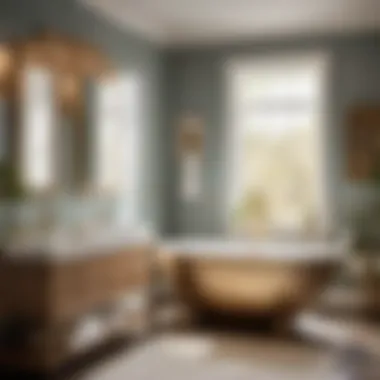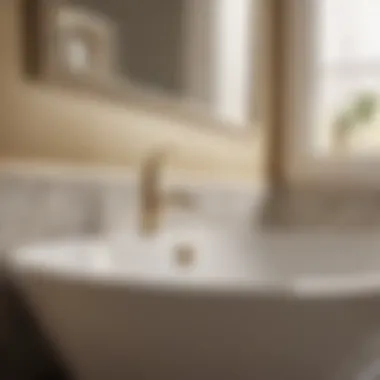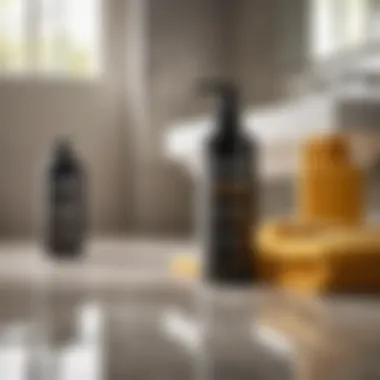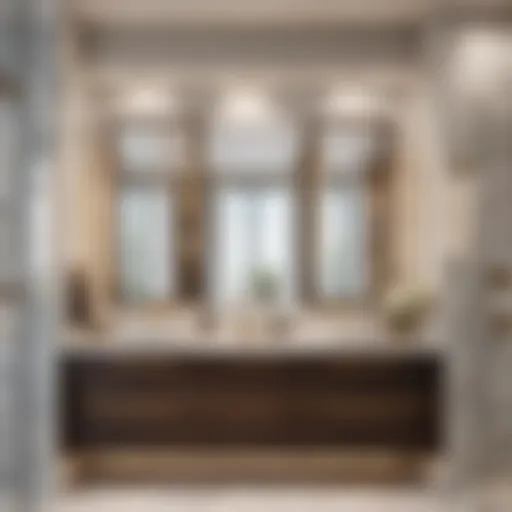Unlocking the Secrets of Bathroom Sealer Paint: Your Complete Guide


Materials:
- High-quality bathroom sealer paint (quantity: based on bathroom size)
- Primer specifically designed for bathroom surfaces
- Paintbrushes (different sizes for detailed work)
- Paint roller with extension pole
- Painter's tape for clean lines
- Drop cloths to protect the floor
- Sandpaper for surface preparation
- Cleaning solution and rags to clean the bathroom
- Protective gear including gloves and mask
DIY Steps:
- Preparation: Start by thoroughly cleaning the bathroom surfaces with the cleaning solution and rags. Remove any old paint or sealant residue. Sand down the surfaces to ensure a smooth base for painting.
- Priming: Apply a bathroom-specific primer to the cleaned and prepped surfaces. Allow the primer to dry completely according to the manufacturer's instructions.
- Painting: Use the paintbrushes for detailed work around edges and corners, while employing the paint roller with extension pole for larger areas. Apply the bathroom sealer paint evenly, ensuring full coverage. Let the first coat dry before applying a second coat if needed.
- Finishing Touches: Once the final coat is applied and dried, remove the painter's tape carefully to reveal clean edges. Clean up any paint spills or drips using a damp cloth.
Technical Aspects:
- Tools: Ensure the paintbrushes, roller, primer, and all other tools are of high quality to achieve a professional finish.
- Timing: Follow the recommended drying times for the primer and sealer paint to ensure durability.
- Techniques: Use long, smooth strokes when applying the paint to prevent streaks or uneven coverage.
DIY Project Process:
- Sequential Steps: Follow a systematic approach, starting with cleaning, then priming, painting, and finishing touches.
- Troubleshooting Tips: In case of drips or uneven coverage, lightly sand the area once dry and reapply the paint for a seamless finish.
For housewives and homeowners looking to refresh their bathrooms, this meticulous guide offers a detailed roadmap for achieving a professional-quality bathroom sealant paint application. By following these comprehensive steps and technical insights, you can enhance both the aesthetic appeal and longevity of your bathroom surfaces.
Introduction
When it comes to renovating or refreshing your bathroom, one of the key elements to consider is the application of bathroom sealer paint. This often-overlooked step can make a significant difference in both the aesthetics and the longevity of your bathroom space. In this comprehensive guide, we will delve into the world of bathroom sealer paint, covering its importance and various aspects in detail.
Importance of Bathroom Sealer Paint
Bathroom sealer paint plays a crucial role in protecting your bathroom against the detrimental effects of moisture. Moisture is a common issue in bathrooms due to frequent water exposure, leading to mold, mildew, and degradation of surfaces over time. By applying a high-quality sealer paint, you can create a protective barrier that helps prevent water infiltration and enhances the durability of your bathroom surfaces.
Moreover, bathroom sealer paint can add a layer of defense against stains, discoloration, and general wear and tear, ensuring that your bathroom maintains a fresh and pristine look for years to come. By sealing grout lines, tile surfaces, and other vulnerable areas, you can significantly reduce the risk of water damage and the need for costly repairs in the future.
In addition to its protective benefits, bathroom sealer paint also offers aesthetic advantages. With a multitude of color options and finishes available, you can customize the look of your bathroom while providing it with a long-lasting shield against moisture and environmental factors. Whether you prefer a sleek, modern design or a more classic, timeless aesthetic, there is a bathroom sealer paint option to suit your preferences and style.
Considering the high traffic and constant use that most bathrooms experience, investing in quality bathroom sealer paint is a prudent choice for any homeowner. Not only does it enhance the visual appeal of your bathroom, but it also contributes to its overall functionality and maintenance. By prioritizing the application of bathroom sealer paint, you can ensure that your bathroom remains a clean, inviting, and durable space for you and your family to enjoy.


With a solid understanding of the importance of bathroom sealer paint, let's explore the various types of sealers, application methods, benefits, and maintenance tips to equip you with all the necessary knowledge for transforming your bathroom into a stylish and resilient sanctuary.
Importance of Bathroom Sealer Paint
Bathroom sealer paint plays a crucial role in maintaining the integrity and aesthetics of your bathroom. In this article, we will delve into the various aspects that make bathroom sealer paint a vital component of your renovation or maintenance project. When considering the importance of bathroom sealer paint, we must highlight its primary function in preserving the structural integrity of your bathroom. By creating a protective barrier against moisture, bathroom sealer paint helps prevent water damage, mold growth, and deterioration of surfaces over time. Additionally, the aesthetic appeal of your bathroom can be significantly enhanced through the use of bathroom sealer paint, which offers a sleek and polished finish.
Furthermore, the durability and longevity of your bathroom fixtures and surfaces are greatly extended with the application of sealer paint. This preventive measure not only safeguards your investment in the long run but also reduces the need for frequent repairs or replacements. Another key benefit of bathroom sealer paint is its versatility, as it can be applied to various surfaces such as tiles, countertops, and bathtubs, ensuring comprehensive protection throughout your bathroom space. As we navigate through the intricacies of bathroom sealer paint, we will uncover the multiple advantages that make it an indispensable asset in your home improvement toolkit.
Protecting Your Bathroom Against Moisture
Moisture is a common enemy in bathrooms, posing a threat to surfaces and creating a breeding ground for mildew and mold. In this section, we will discuss the importance of safeguarding your bathroom against moisture and how bathroom sealer paint serves as a reliable defense mechanism. Protecting your bathroom against moisture is essential in preventing costly damages and preserving the structural integrity of your space. By sealing surfaces with specialized bathroom sealer paint, you create a shield that repels water and inhibits the growth of harmful microorganisms.
Moreover, moisture-resistant bathroom sealer paint acts as a barrier that reduces the risk of water infiltration, which can lead to cracks, warping, or discoloration. Whether you have a newly renovated bathroom or are looking to upgrade your current one, investing in high-quality bathroom sealer paint is a wise decision that ensures long-term protection. By prioritizing moisture protection, you not only maintain a hygienic environment but also prolong the lifespan of your bathroom fixtures and surfaces. Stay tuned as we explore the nuanced strategies for effectively safeguarding your bathroom against the persistent threat of moisture intrusion.
Types of Bathroom Sealer Paint
When it comes to bathroom sealer paint, understanding the different types is crucial for achieving the best results. The type of sealer paint you choose can significantly impact the durability and longevity of your bathroom surfaces. In this section, we will delve into the specific elements, benefits, and considerations of the various types of bathroom sealer paint available in the market.
Epoxy Sealers
Epoxy sealers are renowned for their exceptional durability and resistance to moisture, making them a popular choice for high-moisture areas like bathrooms. These sealers create a tough, protective barrier that is highly effective in preventing water damage and mold growth. Epoxy sealers offer excellent adhesion to various surfaces, including tile, grout, and concrete, ensuring long-lasting protection.
Moreover, epoxy sealers come in a wide range of colors and finishes, allowing you to customize the look of your bathroom while providing outstanding protection. However, it is essential to note that epoxy sealers can be challenging to apply, requiring careful surface preparation and precise application techniques to achieve optimal results.
Acrylic Sealers
Acrylic sealers are known for their versatility and ease of application, making them a popular choice for DIY enthusiasts. These sealers provide a protective layer that enhances the appearance of bathroom surfaces while offering decent protection against moisture and stains. Acrylic sealers are available in various finishes, from matte to glossy, allowing you to achieve the desired look for your bathroom.
One of the key benefits of acrylic sealers is their quick drying time, enabling you to complete your sealing project efficiently. However, acrylic sealers may not provide as robust protection as epoxy sealers against harsh cleaning chemicals and prolonged exposure to water. It is important to consider the specific needs of your bathroom before choosing an acrylic sealer.
Silicone Sealers
Silicone sealers are valued for their superior water-resistant properties, making them ideal for sealing joints and seams in bathroom surfaces. These sealers create a flexible, watertight seal that prevents water infiltration, reducing the risk of water damage and mildew growth. Silicone sealers are particularly effective in areas prone to high levels of moisture, such as showers and bathtubs.


Additionally, silicone sealers exhibit excellent flexibility, allowing them to withstand expansion and contraction of joints without cracking or peeling. While silicone sealers offer exceptional water resistance, they may require more frequent reapplication compared to epoxy and acrylic sealers due to their exposure to constant moisture.
Application Methods
In this comprehensive guide to bathroom sealer paint, the section on application methods plays a crucial role in ensuring the successful application and performance of the sealant. Understanding the right techniques for applying bathroom sealer paint is essential for achieving optimal results and long-lasting protection against moisture and other environmental factors.
When it comes to application methods, there are several specific elements to consider. Firstly, proper surface preparation is key to the adhesion and effectiveness of the sealer paint. Cleaning the surface thoroughly, removing any existing sealant or residue, and ensuring a smooth, dry surface are fundamental steps in this process.
Furthermore, choosing the right tools for applying the sealer paint is paramount. Common tools include paintbrushes, rollers, or even sprayers, each offering different advantages based on the type of sealer paint being used and the size of the application area. Understanding which tool suits your project best can significantly impact the final outcome.
Finally, the actual application of the sealer paint requires attention to detail. Whether applying epoxy, acrylic, or silicone sealers, ensuring uniform coverage, avoiding overlapping strokes, and following manufacturer's instructions are critical for a successful application. Proper ventilation and drying time between coats are also crucial factors to consider to achieve a flawless finish.
This section underscores the significance of mastering the application methods for bathroom sealer paint to safeguard your bathroom surfaces effectively and prolong their durability and aesthetic appeal.
Preparation of the Surface
Preparing the surface before applying bathroom sealer paint is a vital step that directly influences the quality and longevity of the sealant. The preparation process involves meticulously cleaning the surface to remove any dirt, grime, old sealant, or contaminants that could hinder the adhesion of the new sealant.
Before starting the preparation, it's crucial to inspect the surface for any damages or imperfections that need to be addressed. Fixing cracks, holes, or uneven areas ensures a smooth and even application of the sealer. Additionally, ensuring that the surface is completely dry is essential to prevent any moisture from being trapped beneath the new sealant.
Depending on the type of surface and sealant used, specific cleaning methods may vary. However, common steps include using a degreasing cleaner, sanding any rough areas, and applying a primer if necessary. Proper surface preparation sets the foundation for a successful application, enhancing the bond between the sealant and the surface for optimal results.
Choosing the Right Tools
Selecting the appropriate tools for applying bathroom sealer paint is a critical aspect that contributes to the efficiency and quality of the application. The right tools not only ensure a smooth and even coat but also make the application process more manageable and effective.
When choosing tools for applying sealer paint, consider factors like the type of sealant being used, the size of the project, and personal comfort and familiarity with different tools. Paintbrushes are suitable for intricate details and edges, while rollers are efficient for covering larger surface areas quickly.
Additionally, sprayers can provide a more uniform coat of sealer paint, especially for larger projects. It's essential to select high-quality tools that are appropriate for the specific sealant type and project requirements to achieve professional results.
Applying the Sealer Paint


The final step in the application process of bathroom sealer paint is actually applying the sealant onto the prepared surface. This step requires patience, precision, and adherence to recommended techniques to ensure a flawless finish and maximum effectiveness of the sealant.
Start by applying the sealer paint in thin, even coats to prevent drips, runs, or uneven coverage. Work methodically from one side to the other, ensuring no areas are missed or overlapped excessively. Follow any specific instructions provided by the manufacturer regarding drying times, ventilation, and additional coats.
For epoxy sealers, it's essential to mix the components correctly before application to activate the curing process. Acrylic and silicone sealers may have different application requirements, such as specific temperatures or humidity levels for optimal results. Paying attention to these details during the application process can significantly impact the longevity and performance of the bathroom sealer paint.
Mastering the art of applying sealer paint can transform your bathroom surfaces, protecting them against moisture and daily wear while enhancing their aesthetic appeal for years to come.
Benefits of Bathroom Sealer Paint
Bathroom sealer paint is a vital component in ensuring the longevity and durability of your bathroom surfaces. By applying a high-quality sealer paint, you create a protective barrier that shields your walls and floors from moisture, mold, and stains. One of the key benefits of using bathroom sealer paint is its ability to enhance the lifespan of your bathroom fixtures and surfaces, saving you both time and money in the long run.
Additionally, bathroom sealer paint can also improve the aesthetic appeal of your bathroom. With a glossy or matte finish, depending on your preference, you can elevate the overall look of your space while maintaining functionality and practicality. Moreover, some types of bathroom sealer paint offer anti-slip properties, adding an extra layer of safety to your bathroom.
When considering the benefits of bathroom sealer paint, it's essential to take into account the variety of options available in the market. Depending on your specific needs and budget, you can choose from epoxy sealers, acrylic sealers, or silicone sealers, each offering unique advantages and features. Understanding these differences can help you make an informed decision that aligns with your bathroom renovation goals.
Furthermore, the ease of maintenance associated with bathroom sealer paint is another significant benefit. By applying a quality sealer paint, you can simplify the cleaning process and protect your bathroom surfaces from daily wear and tear. Regular cleaning becomes more efficient, as the sealer paint acts as a shield against dirt and grime, maintaining the pristine condition of your bathroom for years to come.
Enhanced Durability and Longevity
Enhanced durability and longevity are key factors that make bathroom sealer paint a preferred choice for homeowners and DIY enthusiasts. The special formulation of sealer paint not only provides protection against moisture and mold but also enhances the durability of bathroom surfaces over time.
With enhanced durability, bathroom sealer paint helps prevent cracking, peeling, and discoloration of walls and floors. The tough barrier created by the sealer paint acts as a shield, preserving the integrity of your bathroom surfaces even in high-moisture environments. This longevity is crucial for maintaining the overall value of your home and ensuring that your bathroom remains functional and visually appealing for years to come.
Moreover, the longevity of bathroom sealer paint reduces the need for frequent renovations or repairs. By investing in a quality sealer paint upfront, you can enjoy long-lasting protection that requires minimal upkeep. This not only saves you time and effort but also minimizes the potential for costly damage to your bathroom fixtures and structures.
In addition to protecting against water damage, enhanced durability and longevity also contribute to the health and safety of your household. By preventing mold growth and maintaining clean and hygienic surfaces, bathroom sealer paint creates a healthier environment for you and your family. This peace of mind is invaluable and underscores the importance of choosing the right sealer paint for your bathroom renovation projects.
Regular Cleaning
Regular cleaning is an essential maintenance tip that plays a pivotal role in preserving the quality and appearance of your bathroom sealer paint. By engaging in consistent cleaning practices, you can prevent the accumulation of dirt, grime, and other contaminants on the painted surfaces, maintaining a fresh and pristine look in your bathroom. Regular cleaning not only enhances the aesthetic appeal of your bathroom but also contributes to a healthier and more hygienic environment for you and your family.
When it comes to regular cleaning, it's essential to establish a routine that effectively removes dirt and stains without causing damage to the sealer paint. Begin by dusting or wiping down the surfaces with a soft cloth or sponge to eliminate surface debris. For more stubborn stains, consider using a mild detergent diluted in water to gently clean the painted surfaces.
Additionally, pay special attention to areas prone to moisture or humidity, such as around the shower or bathtub, as these areas are more susceptible to mold and mildew growth. Use a mold-inhibiting cleaner to prevent the buildup of mold and mildew, ensuring a clean and hygienic environment in your bathroom.
Regular cleaning not only maintains the appearance of the bathroom but also helps extend the lifespan of the sealer paint. By preventing the accumulation of contaminants and grime, you can prolong the vibrancy and effectiveness of the paint, reducing the need for frequent reapplications. Consistent cleaning practices contribute to the overall durability and longevity of the bathroom sealer paint, ensuring that it remains in excellent condition for years to come.
In summary, regular cleaning is a fundamental maintenance tip that promotes the longevity and performance of bathroom sealer paint. By incorporating consistent cleaning practices into your routine, you can preserve the quality and appearance of your bathroom, creating a welcoming and sanitary space for you and your family to enjoy.







